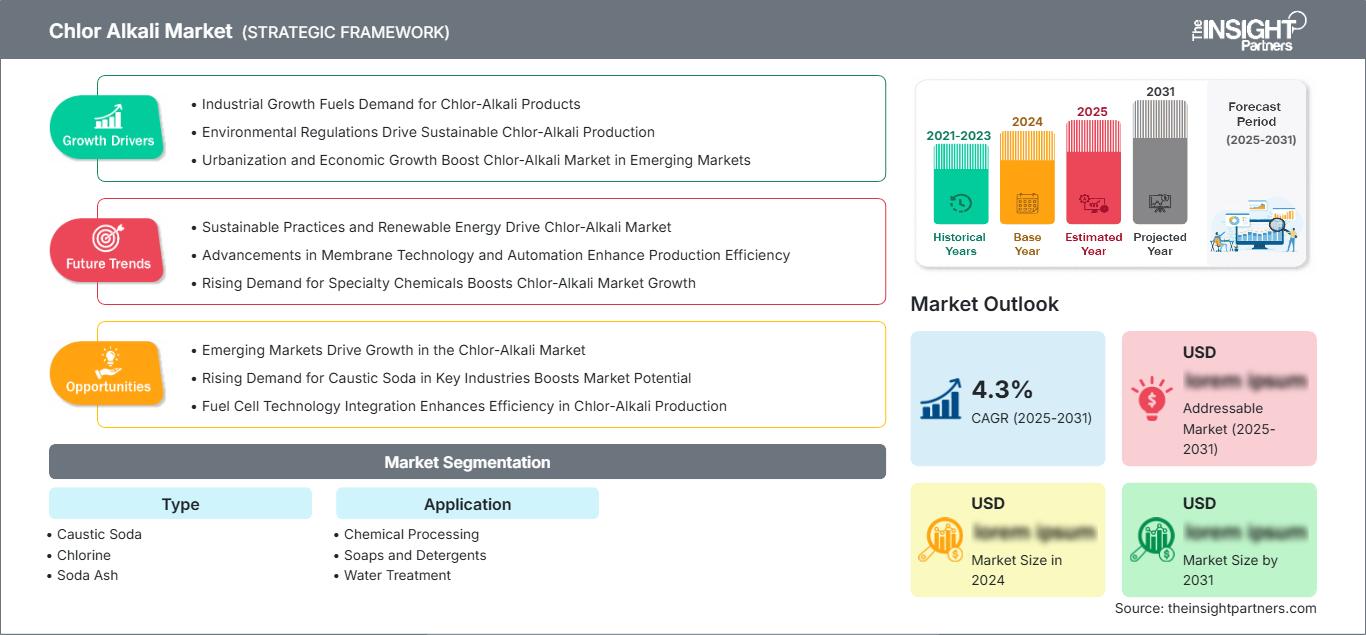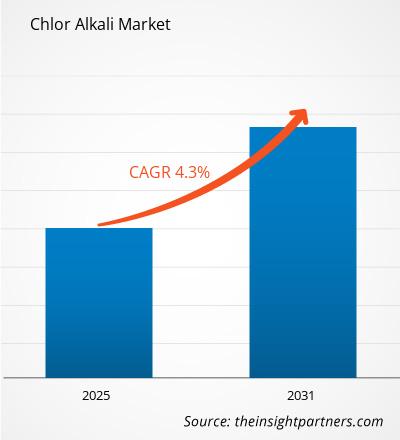Der Chlor-Alkali-Markt wird voraussichtlich zwischen 2025 und 2031 eine durchschnittliche jährliche Wachstumsrate (CAGR) von 4,3 % verzeichnen, wobei die Marktgröße von XX Millionen US-Dollar im Jahr 2024 auf XX Millionen US-Dollar im Jahr 2031 anwachsen wird.
Der Bericht ist nach Produkttyp segmentiert (Ätznatron, Chlor, Soda, sonstige). Der Bericht enthält außerdem Analysen nach Anwendung (chemische Verarbeitung, Seifen und Reinigungsmittel, Wasseraufbereitung, Papier und Zellstoff, Textilien, Lebensmittelverarbeitung und sonstige). Der Bericht umfasst 5 Regionen: Nordamerika, Europa, Asien-Pazifik, Naher Osten und Afrika sowie Süd- und Mittelamerika und die wichtigsten Länder jeder Region. Die globale Analyse ist weiter auf regionaler Ebene und nach den wichtigsten Ländern aufgeschlüsselt. Der Bericht bietet den Wert in USD für die oben genannte Analyse und Segmente.
Zweck des Berichts
Der Bericht „Chlor-Alkali-Markt“ von The Insight Partners zielt darauf ab, die aktuelle Situation und das zukünftige Wachstum sowie die wichtigsten treibenden Faktoren, Herausforderungen und Chancen zu beschreiben. Dadurch erhalten verschiedene Geschäftsinteressenten Einblicke, beispielsweise:
- Technologieanbieter/-hersteller: Um die sich entwickelnde Marktdynamik zu verstehen und die potenziellen Wachstumschancen zu kennen, sodass sie fundierte strategische Entscheidungen treffen können.
- Investoren: Um eine umfassende Trendanalyse hinsichtlich der Marktwachstumsrate, der finanziellen Marktprognosen und der Chancen entlang der Wertschöpfungskette durchzuführen.
- Regulierungsbehörden: Um Richtlinien und Überwachungsaktivitäten auf dem Markt zu regulieren, mit dem Ziel, Missbrauch zu minimieren, das Vertrauen der Investoren zu wahren und die Integrität und Stabilität des Marktes aufrechtzuerhalten.
Marktsegmentierung für Chloralkali
- Ätznatron
- Chlor
- Soda
- Sonstige
Anwendung
- Chemische Verarbeitung
- Seifen und Reinigungsmittel
- Wasseraufbereitung
- Papier und Zellstoff
- Textil
- Lebensmittelverarbeitung
- Sonstige
Sie erhalten kostenlos Anpassungen an jedem Bericht, einschließlich Teilen dieses Berichts oder einer Analyse auf Länderebene, eines Excel-Datenpakets sowie tolle Angebote und Rabatte für Start-ups und Universitäten.
Chlor-Alkali-Markt: Strategische Einblicke

- Holen Sie sich die wichtigsten Markttrends aus diesem Bericht.Dieses KOSTENLOSE Beispiel umfasst Datenanalysen, die von Markttrends bis hin zu Schätzungen und Prognosen reichen.
Wachstumstreiber im Chlor-Alkali-Markt
- Industrielles Wachstum treibt Nachfrage nach Chlor-Alkali-Produkten: Im Chlor-Alkali-Verfahren werden wichtige Chemikalien wie Chlor und Natronlauge hergestellt, die in zahlreichen Branchen wie der Zellstoff- und Papierindustrie, der Textilindustrie und der Wasseraufbereitung eine entscheidende Rolle spielen. Die zunehmende Industrialisierung und der Ausbau der Infrastruktur treiben die weltweite Nachfrage nach diesen Chemikalien an.
- Umweltvorschriften fördern nachhaltige Chlor-Alkali-Produktion: Strengere Umweltvorschriften fördern die Einführung von Chlor-Alkali-Produkten, die Nachhaltigkeitsziele verfolgen. Fortschritte bei den Produktionsmethoden minimieren Emissionen und Abfall und veranlassen die Industrie, diese umweltfreundlichen Optionen zu nutzen, was wiederum das Wachstum des Chlor-Alkali-Marktes unterstützt.
- Urbanisierung und Wirtschaftswachstum kurbeln den Chlor-Alkali-Markt in Schwellenländern an: Die schnelle Urbanisierung und das Wirtschaftswachstum in Schwellenländern treiben die Nachfrage nach Chlor-Alkali-Produkten in die Höhe. Die wachsenden Bau-, Automobil- und Konsumgüterindustrien in Ländern wie Indien und Brasilien bieten Chlor-Alkali-Produzenten erhebliche Chancen, ihre Marktpräsenz zu stärken.
Zukünftige Trends im Chlor-Alkali-Markt
- Nachhaltige Verfahren und erneuerbare Energien treiben den Chlor-Alkali-Markt voran: Der Chlor-Alkali-Markt setzt zunehmend auf nachhaltige Verfahren mit Schwerpunkt auf der Minimierung des CO2-Fußabdrucks. Neue Fortschritte in der Elektrolyse und der Nutzung erneuerbarer Energiequellen werden eingeführt und sprechen Branchen an, die nach umweltfreundlichen Methoden der chemischen Produktion suchen und die allgemeine Nachhaltigkeit des Marktes verbessern.
- Fortschritte in der Membrantechnologie und Automatisierung steigern die Produktionseffizienz: Jüngste Fortschritte in der Membrantechnologie und Automatisierung steigern die Effizienz der Chlor-Alkali-Produktionsprozesse. Diese Verbesserungen führen zu niedrigeren Kosten und höherem Ausstoß und machen den Markt wettbewerbsfähiger und attraktiver für Hersteller, die ihre Produktionskapazitäten erweitern möchten.
- Steigende Nachfrage nach Spezialchemikalien fördert Wachstum des Chlor-Alkali-Marktes: Die steigende Nachfrage nach Spezialchemikalien, insbesondere in den Bereichen Pharma und Körperpflege, treibt den Chlor-Alkali-Markt an. Da die Industrie hochreines Chlor und Natronlauge für fortschrittlichere Anwendungen sucht, passen die Hersteller ihre Prozesse an, um diese speziellen Anforderungen zu erfüllen.
Chancen im Chlor-Alkali-Markt
- Schwellenländer treiben Wachstum im Chlor-Alkali-Markt: Länder wie Brasilien, China, Südafrika und Argentinien bieten erhebliches Wachstumspotenzial für den Chlor-Alkali-Markt. Die rasante Industrialisierung und Urbanisierung in diesen Regionen treibt die Nachfrage nach wichtigen Chemikalien an und ermöglicht es den Herstellern, neue Kunden zu erreichen und ihre Marktposition zu stärken.
- Steigende Nachfrage nach Natronlauge in Schlüsselindustrien steigert Marktpotenzial: Die steigende Nachfrage nach Natronlauge in verschiedenen Sektoren wie der Textil-, Papier- und Lebensmittelverarbeitung bietet Chlor-Alkali-Herstellern erhebliche Chancen. Da diese Branchen weiter wachsen und sich weiterentwickeln, wird der Bedarf an hochwertiger Natronlauge sowohl die Produktion als auch das Umsatzwachstum auf dem Markt vorantreiben.
- Integration der Brennstoffzellentechnologie steigert die Effizienz der Chlor-Alkali-Produktion: Die Integration der Brennstoffzellentechnologie in die Chlor-Alkali-Produktion bietet eine einzigartige Chance. Durch die Kombination der Wasserstoffproduktion mit elektrischen Antriebseinheiten können Hersteller die Energieeffizienz verbessern und die Betriebskosten senken und sich so als Vorreiter in der nachhaltigen Chemieproduktion etablieren.
Regionale Einblicke in den Chloralkali-Markt
Die Analysten von The Insight Partners haben die regionalen Trends und Faktoren, die den Chloralkali-Markt im Prognosezeitraum beeinflussen, ausführlich erläutert. In diesem Abschnitt werden auch die Marktsegmente und die geografische Lage von Chloralkali in Nordamerika, Europa, im asiatisch-pazifischen Raum, im Nahen Osten und Afrika sowie in Süd- und Mittelamerika erörtert.
Umfang des Marktberichts über Chloralkali
| Berichtsattribut | Einzelheiten |
|---|---|
| Marktgröße in 2024 | US$ XX million |
| Marktgröße nach 2031 | US$ XX Million |
| Globale CAGR (2025 - 2031) | 4.3% |
| Historische Daten | 2021-2023 |
| Prognosezeitraum | 2025-2031 |
| Abgedeckte Segmente |
By Typ
|
| Abgedeckte Regionen und Länder | Nordamerika
|
| Marktführer und wichtige Unternehmensprofile |
|
Dichte der Marktteilnehmer für Chloralkali: Verständnis ihrer Auswirkungen auf die Geschäftsdynamik
Der Chloralkali-Markt wächst rasant, angetrieben durch die steigende Endverbrauchernachfrage aufgrund von Faktoren wie sich entwickelnden Verbraucherpräferenzen, technologischem Fortschritt und einem stärkeren Bewusstsein für die Produktvorteile. Mit steigender Nachfrage erweitern Unternehmen ihr Angebot, entwickeln Innovationen, um den Verbraucherbedürfnissen gerecht zu werden, und nutzen neue Trends, was das Marktwachstum weiter ankurbelt.

- Holen Sie sich die Chlor-Alkali-Markt Übersicht der wichtigsten Akteure
Wichtige Verkaufsargumente
- Umfassende Abdeckung: Der Bericht analysiert umfassend Produkte, Dienstleistungen, Typen und Endnutzer des Chlor-Alkali-Marktes und bietet einen ganzheitlichen Überblick.
- Expertenanalyse: Der Bericht basiert auf dem umfassenden Verständnis von Branchenexperten und Analysten.
- Aktuelle Informationen: Der Bericht gewährleistet Geschäftsrelevanz durch die Berichterstattung über aktuelle Informationen und Datentrends.
- Anpassungsoptionen: Dieser Bericht kann an spezifische Kundenanforderungen angepasst werden und passt sich den Geschäftsstrategien optimal an.
Der Forschungsbericht zum Chlor-Alkali-Markt kann daher dazu beitragen, die Branchensituation und die Wachstumsaussichten zu entschlüsseln und zu verstehen. Obwohl es einige berechtigte Bedenken geben kann, überwiegen die Vorteile dieses Berichts tendenziell die Nachteile.
- Historische Analyse (2 Jahre), Basisjahr, Prognose (7 Jahre) mit CAGR
- PEST- und SWOT-Analyse
- Marktgröße Wert/Volumen – Global, Regional, Land
- Branchen- und Wettbewerbslandschaft
- Excel-Datensatz
Aktuelle Berichte
Erfahrungsberichte
Grund zum Kauf
- Fundierte Entscheidungsfindung
- Marktdynamik verstehen
- Wettbewerbsanalyse
- Kundeneinblicke
- Marktprognosen
- Risikominimierung
- Strategische Planung
- Investitionsbegründung
- Identifizierung neuer Märkte
- Verbesserung von Marketingstrategien
- Steigerung der Betriebseffizienz
- Anpassung an regulatorische Trends






















 Kostenlose Probe anfordern für - Chlor-Alkali-Markt
Kostenlose Probe anfordern für - Chlor-Alkali-Markt